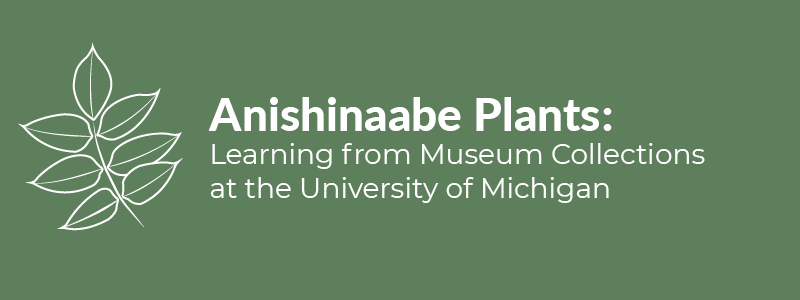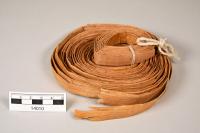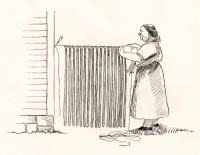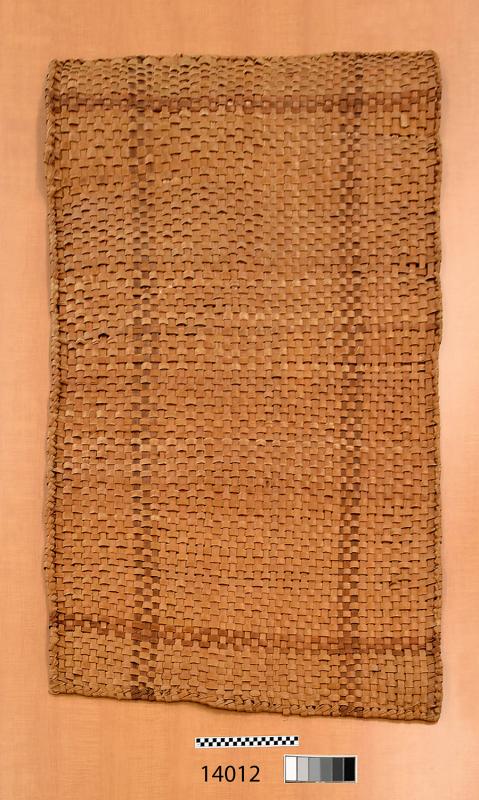Cedar Mat Making
Gathering Cedar
Mr. Neil Boyer gathered the cedar bark that was used to create the cedar mat and cedar bag collected by Jones. The Belanger & Boyer family spoke of the importance of gathering bark in June and July when the sap was flowing and it “slips” from the trunk readily.
Selecting a cedar tree between 6 inches to a foot in diameter, Mr. Boyer notched the bark around the trunk, pulling it loose in long strips while leaving at least a third of the bark on the trunk so that it might continue to grow. To create the cedar strips for weaving one cedar mat, 7 cedar trees were stripped, producing up to 4 strips from each tree that were between 3 to 5 inches wide and 20 to 25 feet long. Mr. Boyer bent the strips back and forth, and then peeled away and discarded the rough outer edge of the bark. Only the soft, flexible inner bark was used for weaving. Strips were then bundled together using basswood twine.
Preparing Cedar
Mary Belanger and Sophia (Belanger) Boyer cut with scissors the inner bark into thin, less than an inch strips while they were still moist. Short, 4 feet long strips were cut for the warp while longer 6 feet strips were cut for the weft. Mrs. Belanger dyed 6 warp and 6 weft strips by immersing them in a liquid made from boiling bloodroot. The rich red color left by the bloodroot is still visible in the cedar mat today, nearly 100 years after the strips were originally dyed and woven. Learn more about natural dyes.
Mr. Boyer constructed a large frame with a crosspiece for weaving. Normally, cedar mats were woven in the shade to protect them from drying out. Mr. Boyer nailed the frame to the ceilings beams within Mrs. Belanger's house and the weaving began.
Weaving Cedar
Warp and weft are two basic components of weaving textiles. The warp runs horizontally on a frame and holds tension, while the weft is woven under and over the warp, often in combinations to create a specific pattern. Mrs Belanger created the warp by knotting strips to a long cord made of basswood. With its many warp strips hanging from it, the cord was then fastened to the weaving frame.
Weaving of the weft involved Mrs. Belanger, Mrs. Boyer, and Jones. The first weft strip was fastened to a left hanging basswood cord, and then woven over and under warp strips repeatedly. The second weft strip was similarly tied, but woven first under and then over the warp strips. This alternating back and forth between strips is known as "plain plaiting" or as a "checker weave." Once some or all of the strips were woven, the weft was partially or completely tied off on the right side in a similar pattern used for fastening warp strips to the basswood cord. Once completed, the warp was tied off at the bottom.
Kiishik Naakniiganke - Cedar Mat Making Today
Today, renowned Anishinaabe fiber artist Wasson (Renée Dillard) led a cedar weaving workshop with the Little Traverse Bay Bands of Odawa Indians. Students began by practicing weaving and making small individual mats in preparation for making a much larger feasting mat. Dillard says that feasting mats feed you physically while the food on the mat can be offered directly to Grandmother Cedar.
Dillard seasoned cedar bark strips for more than a year before the workshop, splitting and cutting it in a similar manner to black ash basketry. When making the large feasting mat, she used a "twill weave", meaning weft strips were woven under one over two, or vice versa, across the warp. Dillard's mother taught her that making baskets isn't a hobby, it's a way of life. In the case of this workshop, "[t]his is one way for us to come together as a people, to create these feast mats that can be used by anyone in the community. We make feasts so ancestors can come in and enjoy the food with us and recognize what's going on because there will be things from their time on earth they will recognize."
To learn more about this workshop and learn from Renee Dillard, watch the video below.
Video by Little Traverse Bay Bands of Odawa Indians Tribal Historic Preservation Office, posted August 2, 2018.






